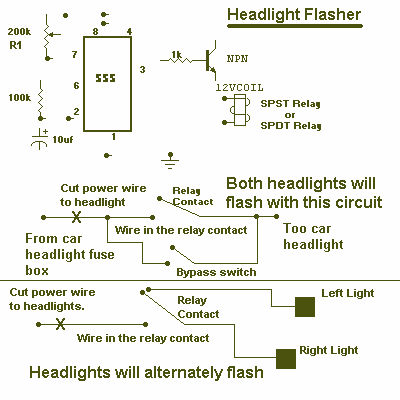
Simple Emergency Light

This is an automatic emergency lamp equipped with daylight sensing capabilities, enabling it to detect darkness and automatically turn on. Conversely, it senses daylight and turns off automatically. This straightforward emergency lamp does not require any special equipment, not even a multimeter, for assembly and use. Anyone with good soldering skills can successfully build this circuit. It can be easily housed in a defunct two 6-watt tube National Emergency Lamp or any PL tube type emergency lamp. The circuit is designed to operate continuously for over 8 hours. Deep discharge protection is managed by the LED characteristics, while overcharge protection is provided by a fixed voltage regulator. The circuit utilizes a simple 3-pin fixed regulator with an integrated current limiting circuit. The only necessary adjustment is a preset that must be configured to ensure the LEDs illuminate just enough (this should remain at that setting). A 5mm Light Dependent Resistor (LDR) is mounted on top of the emergency light, as illustrated in the accompanying photograph. The LDR prevents the lamp from illuminating during daytime or when room lights are on. Two LEDs are connected in series, eliminating the need for dropping resistance; this configuration allows both LEDs to operate with the current required for a single LED, significantly conserving energy. This circuit has been intentionally simplified for individuals with limited access to components, making it an emergency light that can be constructed with minimal components. Along with the circuit diagram, photographs of the prototype created in the National emergency light and a PCB design have been shared.
The automatic emergency lamp circuit is designed to provide reliable lighting during power outages or low-light conditions. The core functionality relies on the LDR, which detects ambient light levels. When the light level drops below a certain threshold, the LDR's resistance increases, triggering the circuit to activate the LEDs. Conversely, when the light level rises above the threshold, the LDR's resistance decreases, causing the circuit to deactivate the LEDs.
The 3-pin fixed voltage regulator is crucial for maintaining a stable voltage output, ensuring that the LEDs operate efficiently without risk of damage from overvoltage. The built-in current limiting feature protects the circuit from excessive current draw, which is particularly important when dealing with rechargeable batteries. The design allows for the use of standard components, making it accessible for hobbyists and those with limited resources.
The choice to connect two LEDs in series is a strategic decision that enhances energy efficiency. By using two LEDs, the circuit can achieve greater brightness without requiring additional current, thus prolonging battery life. The absence of a dropping resistor simplifies the design and reduces component count, making it easier to assemble.
The housing of the circuit in a repurposed emergency lamp not only promotes sustainability but also provides a practical application for the design. The prototype photographs and PCB design included with the documentation serve as valuable references for builders, offering visual guidance for assembly and layout. Overall, this automatic emergency lamp circuit exemplifies a user-friendly approach to creating an efficient lighting solution.This is an automatic emergency lamp with day light sensing, means it senses darkness/night and turns ON automatically. Similarly it senses day light and turns OFF automatically. A simple emergency lamp which does not require any special equipment; even a multimeter to assemble and use.
Any individual who can do a good quality soldering must be abl e to build this circuit successfully. This can be easily accommodated in the defunct two 6 watt tube National Emergency Lamp or any PL tube type emergency lamp. The difference will be in the working; it will work non stop for more than 8 hours. Deep discharge is taken care by the LED characteristic and over charge protection is taken care by the fixed voltage regulator.
This uses a simple 3Pin fixed regulator which has a built in current limiting circuit. The only required adjustment is the preset which has to be set to ensure the LEDs just light up (it should be left at that position). The 5mm LDR is just mounted on top of the emergency light as shown in the photograph. LDR is used to avoid it lighting up during day time or when the room lights are ON. 2 LEDs are used in series; the dropping resistance is avoided and 2 LEDs light up with current that is required for a single LED, by which energy is saved to a great extent.
This particular circuit has been kept so simple for people who has limited access to components or in other words this is an emergency light that you can build with minimum components. In addition to circuit diagram, He has shared photographs of the prototype he made in National emergency light and a PCB design.
🔗 External reference
The automatic emergency lamp circuit is designed to provide reliable lighting during power outages or low-light conditions. The core functionality relies on the LDR, which detects ambient light levels. When the light level drops below a certain threshold, the LDR's resistance increases, triggering the circuit to activate the LEDs. Conversely, when the light level rises above the threshold, the LDR's resistance decreases, causing the circuit to deactivate the LEDs.
The 3-pin fixed voltage regulator is crucial for maintaining a stable voltage output, ensuring that the LEDs operate efficiently without risk of damage from overvoltage. The built-in current limiting feature protects the circuit from excessive current draw, which is particularly important when dealing with rechargeable batteries. The design allows for the use of standard components, making it accessible for hobbyists and those with limited resources.
The choice to connect two LEDs in series is a strategic decision that enhances energy efficiency. By using two LEDs, the circuit can achieve greater brightness without requiring additional current, thus prolonging battery life. The absence of a dropping resistor simplifies the design and reduces component count, making it easier to assemble.
The housing of the circuit in a repurposed emergency lamp not only promotes sustainability but also provides a practical application for the design. The prototype photographs and PCB design included with the documentation serve as valuable references for builders, offering visual guidance for assembly and layout. Overall, this automatic emergency lamp circuit exemplifies a user-friendly approach to creating an efficient lighting solution.This is an automatic emergency lamp with day light sensing, means it senses darkness/night and turns ON automatically. Similarly it senses day light and turns OFF automatically. A simple emergency lamp which does not require any special equipment; even a multimeter to assemble and use.
Any individual who can do a good quality soldering must be abl e to build this circuit successfully. This can be easily accommodated in the defunct two 6 watt tube National Emergency Lamp or any PL tube type emergency lamp. The difference will be in the working; it will work non stop for more than 8 hours. Deep discharge is taken care by the LED characteristic and over charge protection is taken care by the fixed voltage regulator.
This uses a simple 3Pin fixed regulator which has a built in current limiting circuit. The only required adjustment is the preset which has to be set to ensure the LEDs just light up (it should be left at that position). The 5mm LDR is just mounted on top of the emergency light as shown in the photograph. LDR is used to avoid it lighting up during day time or when the room lights are ON. 2 LEDs are used in series; the dropping resistance is avoided and 2 LEDs light up with current that is required for a single LED, by which energy is saved to a great extent.
This particular circuit has been kept so simple for people who has limited access to components or in other words this is an emergency light that you can build with minimum components. In addition to circuit diagram, He has shared photographs of the prototype he made in National emergency light and a PCB design.
🔗 External reference
Warning: include(partials/cookie-banner.php): Failed to open stream: Permission denied in /var/www/html/nextgr/view-circuit.php on line 713
Warning: include(): Failed opening 'partials/cookie-banner.php' for inclusion (include_path='.:/usr/share/php') in /var/www/html/nextgr/view-circuit.php on line 713





